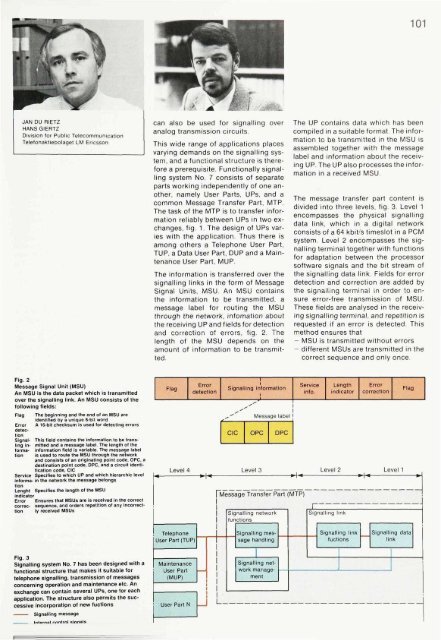diavox courier 700, digital system telephone for md 110 data
diavox courier 700, digital system telephone for md 110 data
diavox courier 700, digital system telephone for md 110 data
Create successful ePaper yourself
Turn your PDF publications into a flip-book with our unique Google optimized e-Paper software.
101<br />
JAN DU RIETZ<br />
HANSGIERTZ<br />
Division <strong>for</strong> Public Telecommunication<br />
Telefonaktiebolaget LM Ericsson<br />
can also be used <strong>for</strong> signalling over<br />
analog transmission circuits.<br />
This wide range of applications places<br />
varying demands on the signalling <strong>system</strong>,<br />
and a functional structure is there<strong>for</strong>e<br />
a prerequisite. Functionally signalling<br />
<strong>system</strong> No. 7 consists of separate<br />
parts working independently of one another,<br />
namely User Parts, UPs, and a<br />
common Message Transfer Part, MTP.<br />
The task of the MTP is to transfer in<strong>for</strong>mation<br />
reliably between UPs in two exchanges,<br />
fig. 1. The design of UPs varies<br />
with the application. Thus there is<br />
among others a Telephone User Part,<br />
TUP, a Data User Part, DUP and a Maintenance<br />
User Part, MUP.<br />
The in<strong>for</strong>mation is transferred over the<br />
signalling links in the <strong>for</strong>m of Message<br />
Signal Units, MSU. An MSU contains<br />
the in<strong>for</strong>mation to be transmitted, a<br />
message label <strong>for</strong> routing the MSU<br />
through the network, infomation about<br />
the receiving UP and fields <strong>for</strong> detection<br />
and correction of errors, fig. 2. The<br />
length of the MSU depends on the<br />
amount of in<strong>for</strong>mation to be transmitted.<br />
The UP contains <strong>data</strong> which has been<br />
compiled in a suitable <strong>for</strong>mat The in<strong>for</strong>mation<br />
to be transmitted in the MSU is<br />
assembled together with the message<br />
label and in<strong>for</strong>mation about the receiving<br />
UP. The UP also processes the in<strong>for</strong>mation<br />
in a received MSU.<br />
The message transfer part content is<br />
divided into three levels, fig. 3. Level 1<br />
encompasses the physical signalling<br />
<strong>data</strong> link, which in a <strong>digital</strong> network<br />
consists of a 64 kbit/s timeslot in a PCM<br />
<strong>system</strong>. Level 2 encompasses the signalling<br />
terminal together with functions<br />
<strong>for</strong> adaptation between the processor<br />
software signals and the bit stream of<br />
the signalling <strong>data</strong> link. Fields <strong>for</strong> error<br />
detection and correction are added by<br />
the signalling terminal in order to ensure<br />
error-free transmission of MSU.<br />
These fields are analysed in the receiving<br />
signalling terminal, and repetition is<br />
requested if an error is detected. This<br />
method ensures that<br />
- MSU is transmitted without errors<br />
- different MSUs are transmitted in the<br />
correct sequence and only once.<br />
Fig. 2<br />
Message Signal Unit (MSU)<br />
An MSU is the <strong>data</strong> packet which is transmitted<br />
over the signalling link. An MSU consists of the<br />
following fields:<br />
Flag<br />
Error<br />
detection<br />
Signal-<br />
The beginning and the end of an MSU are<br />
identified by a unique B-bit word<br />
A 16-bit checksum is used <strong>for</strong> detecting errors<br />
This field contains the in<strong>for</strong>mation to be transling<br />
In- mitted and a message label. The length of the<br />
<strong>for</strong>ma- in<strong>for</strong>mation field is variable. The message label<br />
tion is used to route the MSU through the network<br />
and consists of an originating point code, OPC, a<br />
destination point code, DPC, and a circuit identification<br />
code, CIC<br />
Service Specifies to which UP and which hierarchic level<br />
in<strong>for</strong>ma- in the network the message belongs<br />
tlon<br />
Lenght Specifies the length of the MSU<br />
indicator<br />
Error Ensures that MSUs are is received in the correct<br />
correc- sequence, and orders repetition of any Incorrecttion<br />
ly received MSUs<br />
Fig. 3<br />
Signalling <strong>system</strong> No. 7 has been designed with c<br />
functional structure that makes it suitable <strong>for</strong><br />
<strong>telephone</strong> signalling, transmission of messages<br />
concerning operation and maintenance etc. An<br />
exchange can contain several UPs, one <strong>for</strong> each<br />
application. The structure also permits the successive<br />
incorporation of new fuctions<br />
Signalling message<br />
Internal rnntrnl QJanalS
















